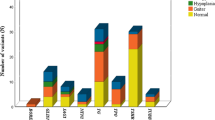Abstract
Context: Congenital hypothyroidism (CH) is a common endocrine disorder with an incidence of 1:3000–4000 newborns. In 80–85% of cases, CH is caused by defects in thyroid organogenesis, resulting in absent, ectopically located, and/or severely reduced gland, all conditions indicated as “thyroid dysgenesis” (TD). A higher prevalence of congenital heart diseases has been documented in children with CH compared to the general population. This association suggests a possible pathogenic role of genes involved in both heart and thyroid development. Among these, it can be included Isl1, a transcription factor containing a LIM homeodomain that is expressed in both thyroid and heart during morphogenesis. Objective: In the present study, we investigate the role of ISL1 in the pathogenesis of TD. Settings and patients: By single stranded conformational polymorphism, we screened for mutations the entire ISL1 coding sequence in 96 patients with TD and in 96 normal controls. Results: No mutations have been found in patients and controls. Conclusion: Our data indicate that, despite the relevant role of ISL1 in thyroid and heart morphogenesis, mutations in its coding region are not associated with TD in our group of patients.
Similar content being viewed by others
References
De Felice M, Di Lauro R. Thyroid development and its disorders: genetics and molecular mechanisms. Endocr Rev 2004, 25: 722–46.
Macchia PE, Fenzi G. Genetic Defects in Thyroid Hormone Supply. In: De Grot LJ ed. www.thyroidmanager.org. South Dartmouth, MA: Endocrine Education Inc, 2009.
Roberts HE, Moore CA, Fernhoff PM, Brown AL, Khoury MJ. Population study of congenital hypothyroidism and associated birth defects, Atlanta, 1979–1992. Am J Med Genet 1997, 71: 29–32.
Olivieri A, Stazi MA, Mastroiacovo P, et al; Study Group for Congenital Hypothyroidism. Apopulation-based studyon the frequency of additional congenital malformations in infants with congenital hypothyroidism: data from the Italian Registry for Congenital Hypothyroidism (1991–1998). J Clin Endocrinol Metab 2002, 87: 557–62.
Kreisner E, Neto EC, Gross JL. High prevalence of extrathyroid malformations in a cohort of Brazilian patients with permanent primary congenital hypothyroidism. Thyroid 2005, 15: 165–69.
Komuro I, Izumo S. Csx: a murine homeobox-containing gene specifically expressed in the developing heart. Proc Natl Acad Sci USA 1993, 90: 8145–9.
Biben C, Weber R, Kesteven S, et al. Cardiac septal and valvular dysmorphogenesis in mice heterozygous for mutations in the homeobox gene Nkx2-5. Circ Res 2000, 87: 888–95.
Tanaka M, Schinke M, Liao HS, Yamasaki N, Izumo S. Nkx2.5 and Nkx2.6, homologs of Drosophila tinman, are required for development of the pharynx. Mol Cell Biol 2001, 21: 4391–8.
Schott JJ, Benson DW, Basson CT, et al. Congenital heart disease caused by mutations in the transcription factor NKX2-5. Science 1998, 281: 108–11.
Leong FT, Freeman LJ, Keavney BD. Fresh fields and pathways new: recent genetic insights into cardiac malformation. Heart 2009, 95: 442–7.
Nemer M. Genetic insights into normal and abnormal heart development. Cardiovasc Pathol 2008, 17: 48–54.
Akazawa H, Komuro I. Cardiac transcription factor Csx/Nkx2-5: Its role in cardiac development and diseases. Pharmacol Ther 2005, 107: 252–68.
Dentice M, Cordeddu V, Rosica A, et al. Missense mutation in the transcription factor NKX2-5: a novel molecular event in the pathogenesis of thyroid dysgenesis. J Clin Endocrinol Metab 2006, 91: 1428–33.
Ahlgren U, Pfaff SL, Jessell TM, Edlund T, Edlund H. Independent requirement for ISL1 in formation of pancreatic mesenchyme and islet cells. Nature 1997, 385: 257–60.
Cai CL, Liang X, Shi Y, et al. Isl1 identifies a cardiac progenitor population that proliferates prior to differentiation and contributes a majority of cells to the heart. Dev Cell 2003, 5: 877–89.
Mann T, Bodmer R, Pandur P. The Drosophila homolog of vertebrate Islet1 is a key component in early cardiogenesis. Development 2009, 136: 317–26.
Lin L, Bu L, Cai CL, Zhang X, Evans S. Isl1 is upstream of sonic hedgehog in a pathway required for cardiac morphogenesis. Dev Biol 2006, 295: 756–63.
Alt B, Elsalini OA, Schrumpf P, et al. Arteries define the position of the thyroid gland during its developmental relocalisation. Development 2006, 133: 3797–804.
Fagman H, Grände M, Gritli-Linde A, Nilsson M. Genetic deletion of sonic hedgehog causes hemiagenesis and ectopic development of the thyroid in mouse. Am J Pathol 2004, 164: 1865–72.
Yuan S, Schoenwolf GC. Islet-1 marks the early heart rudiments and is asymmetrically expressed during early rotation of the foregut in the chick embryo. Anat Rec 2000, 260: 204–7.
Thor S, Ericson J, Brännström T, Edlund T. The homeodomain LIM protein Isl-1 is expressed in subsets of neurons and endocrine cells in the adult rat. Neuron 1991, 7: 881–9.
Westerlund J, Andersson L, Carlsson T, Zoppoli P, Fagman H, Nilsson M. Expression of Islet1 in thyroid development related to budding, migration, and fusion of primordia. Dev Dyn 2008, 237: 3820–9.
Lough J, Sugi Y. Endoderm and heart development. Dev Dyn 2000, 217: 327–42.
Wendl T, Adzic D, Schoenebeck JJ, et al. Early developmental specification of the thyroid gland depends on han-expressing surrounding tissue and on FGF signals. Development 2007, 134: 2871–9.
Black BL. Transcriptional pathways in second heart field development. Semin Cell Dev Biol 2007, 18: 67–76.
Takeuchi JK, Mileikovskaia M, Koshiba-Takeuchi K, et al. Tbx20 dose-dependently regulates transcription factor networks required for mouse heart and motoneuron development. Development 2005, 132: 2463–74.
Author information
Authors and Affiliations
Corresponding author
Rights and permissions
About this article
Cite this article
Ferrara, A.M., Rossi, G., Zampella, E. et al. Screening for mutations in the ISL1 gene in patients with thyroid dysgenesis. J Endocrinol Invest 34, e149–e152 (2011). https://doi.org/10.3275/7331
Accepted:
Published:
Issue Date:
DOI: https://doi.org/10.3275/7331




